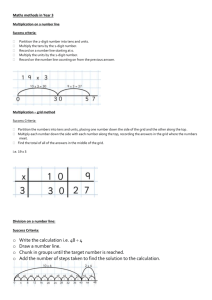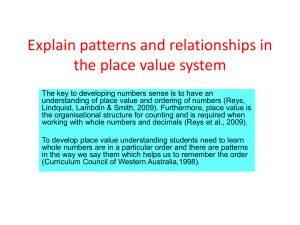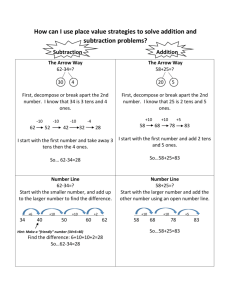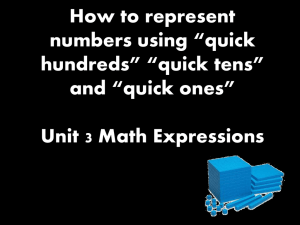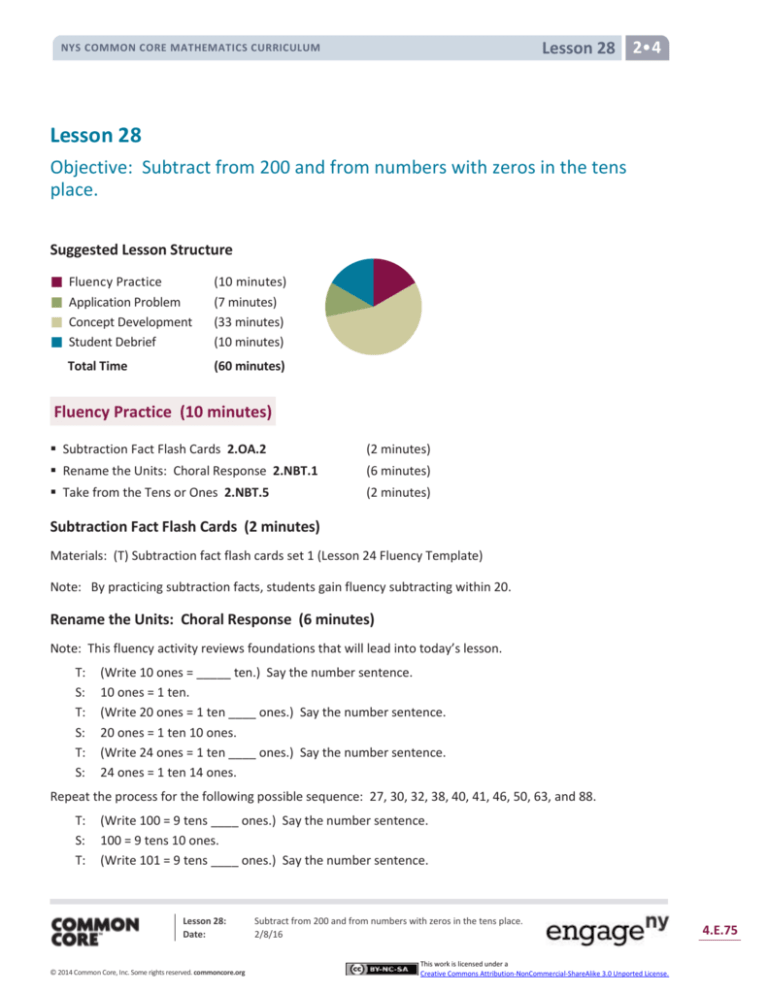
Lesson 28 2•4
NYS COMMON CORE MATHEMATICS CURRICULUM
Lesson 28
Objective: Subtract from 200 and from numbers with zeros in the tens
place.
Suggested Lesson Structure
Fluency Practice
Application Problem
Concept Development
Student Debrief
Total Time
(10 minutes)
(7 minutes)
(33 minutes)
(10 minutes)
(60 minutes)
Fluency Practice (10 minutes)
Subtraction Fact Flash Cards 2.OA.2
(2 minutes)
Rename the Units: Choral Response 2.NBT.1
(6 minutes)
Take from the Tens or Ones 2.NBT.5
(2 minutes)
Subtraction Fact Flash Cards (2 minutes)
Materials: (T) Subtraction fact flash cards set 1 (Lesson 24 Fluency Template)
Note: By practicing subtraction facts, students gain fluency subtracting within 20.
Rename the Units: Choral Response (6 minutes)
Note: This fluency activity reviews foundations that will lead into today’s lesson.
T:
S:
T:
S:
T:
S:
(Write 10 ones = _____ ten.) Say the number sentence.
10 ones = 1 ten.
(Write 20 ones = 1 ten ____ ones.) Say the number sentence.
20 ones = 1 ten 10 ones.
(Write 24 ones = 1 ten ____ ones.) Say the number sentence.
24 ones = 1 ten 14 ones.
Repeat the process for the following possible sequence: 27, 30, 32, 38, 40, 41, 46, 50, 63, and 88.
T:
S:
T:
(Write 100 = 9 tens ____ ones.) Say the number sentence.
100 = 9 tens 10 ones.
(Write 101 = 9 tens ____ ones.) Say the number sentence.
Lesson 28:
Date:
© 2014 Common Core, Inc. Some rights reserved. commoncore.org
Subtract from 200 and from numbers with zeros in the tens place.
2/8/16
This work is licensed under a
Creative Commons Attribution-NonCommercial-ShareAlike 3.0 Unported License.
4.E.75
Lesson 28 2•4
NYS COMMON CORE MATHEMATICS CURRICULUM
S:
T:
S:
T:
S:
101 = 9 tens 11 ones.
9 tens 11 ones is…?
101.
9 tens 12 ones is…?
102.
Repeat the process for the following possible sequence: 103, 104, 105, 106, 107, 108, 109, and 110.
Take from the Tens or Ones (2 minutes)
Note: This fluency activity helps students know when to unbundle a ten to subtract. This is a foundational
skill for the lesson.
T:
T:
S:
T:
S:
For every number sentence I say, you tell me if I take from the tens or the ones. When I say 46 – 5,
you say take from the ones, but If I say 46 – 7, you say take from the tens. Ready?
46 – 6.
Take from the ones.
46 – 9.
Take from the tens.
Continue with the following possible sequence: 52 – 1, 52 – 4, 63 – 6, 64 – 5, 65 – 4, 68 – 8, and 70 – 3.
Application Problem (7 minutes)
Jerry made 200 pizzas. He sold some of them and had 57 pizzas
left. How many did he sell?
Note: Instruct students to set up a place value chart to solve
this Application Problem. Some students may relate this
problem to Lesson 27 by drawing place value disks on their
place value charts. Others may choose to represent the
problem using a tape diagram or the arrow way.
Concept Development (33 minutes)
Materials: (S) Personal white board
Note: This Concept Development is intentionally designed for
students to practice concepts taught in Lesson 27. Encourage
students to choose any accurate math drawing to represent the
subtraction. While some students may be comfortable drawing
chip models, others may choose to represent the problem using
place value disk drawings. In either case, all students should
relate their drawings to the vertical form.
Lesson 28:
Date:
© 2014 Common Core, Inc. Some rights reserved. commoncore.org
A NOTE ON
MULTIPLE MEANS
OF ACTION AND
EXPRESSION:
Have manipulatives available for
students who have not yet mastered
the ability to solve these problems
without a concrete representation.
Subtract from 200 and from numbers with zeros in the tens place.
2/8/16
This work is licensed under a
Creative Commons Attribution-NonCommercial-ShareAlike 3.0 Unported License.
4.E.76
Lesson 28 2•4
NYS COMMON CORE MATHEMATICS CURRICULUM
Problem 1: 106 – 58
T:
T:
S:
T:
S:
T:
S:
T:
S:
T:
S:
MP.4
T:
T:
S:
T:
S:
T:
S:
T:
S:
T:
S:
T:
S:
T:
S:
(Write 106 – 58 on the board.)
Let’s solve 106 – 58 using a math drawing. Choose whether you want to use a disk drawing or a chip
model. What number are we going to draw?
106.
And, what should I draw on my model to show that number?
1 hundred and 6 ones.
Great. Which place do we look at first to see if we need to do any renaming?
The ones!
Are we ready to subtract in the ones place?
No.
What should we do? Turn and talk to your partner.
There are no tens either, so let’s rename a hundred as 9 tens and 10 ones. That makes it 9 tens
and 16 ones, because we already had 6 ones. We can change 1 hundred into 10 tens, and then
change 10 tens into 9 tens 10 ones.
Okay, let’s do it. Record each change.
Are we ready to subtract in the ones?
Yes.
In the tens?
Yes.
Show your answer in the written subtraction. What
is our first step? Tell the units.
16 ones – 8 ones.
(Model on your drawing and algorithm.) How many
ones are left?
8.
Great. Let’s try the tens. What is our problem?
9 tens ─ 5 tens.
How many tens do we have left?
4 tens. (Show this on the drawing and using the algorithm.)
Do we subtract any hundreds?
No!
Invite students to share their work. Analyze the parts and join them to see if they total 106.
Lesson 28:
Date:
© 2014 Common Core, Inc. Some rights reserved. commoncore.org
Subtract from 200 and from numbers with zeros in the tens place.
2/8/16
This work is licensed under a
Creative Commons Attribution-NonCommercial-ShareAlike 3.0 Unported License.
4.E.77
Lesson 28 2•4
NYS COMMON CORE MATHEMATICS CURRICULUM
Problem 2: 200 – 67
T:
T:
MP.4
T:
S:
T:
S:
T:
S:
T:
(Write 200 – 67 on the board.)
We are now going to do the same thing with another problem. Make a math drawing that
represents the number we will be subtracting from. (Give them time to make their drawings.)
What did you draw?
200. 2 hundreds.
How can we rename 200 to solve 200 – 67? Turn and
talk.
We can rename it as 1 hundred, 9 tens, and 10 ones.
Since you can’t subtract from the ones or tens, we can
unbundle a hundred, then unbundle a ten.
In which place will you start subtracting?
The ones.
A NOTE ON
On your own, solve 200 ─ 67 using a math drawing.
MULTIPLE MEANS
Again, record each change and show your answer in the
OF ENGAGEMENT:
written subtraction.
Allow students who prefer to work in
Repeat the above activity with the following possible sequence:
200 – 33, 103 – 59, and 200 – 49. Before students begin each
problem, instruct them to rename the whole. Emphasize the
renaming of 200 as 1 hundred, 9 tens, 10 ones. As you
circulate, remind students to draw the magnifying glass, to
represent the problem using a math drawing, and to record
each step in the written subtraction.
groups to work with a partner on the
Problem Set; likewise, allow students
who concentrate better alone to work
independently.
Problem Set (10 minutes)
Students should do their personal best to complete the
Problem Set within the allotted 10 minutes. For some
classes, it may be appropriate to modify the assignment by
specifying which problems they work on first. Some
problems do not specify a method for solving. Students
should solve these problems using the RDW approach used
for Application Problems.
Student Debrief (10 minutes)
Lesson Objective: Subtract from 200 and from numbers
with zeroes in the tens place.
The Student Debrief is intended to invite reflection and
active processing of the total lesson experience.
Lesson 28:
Date:
© 2014 Common Core, Inc. Some rights reserved. commoncore.org
Subtract from 200 and from numbers with zeros in the tens place.
2/8/16
This work is licensed under a
Creative Commons Attribution-NonCommercial-ShareAlike 3.0 Unported License.
4.E.78
Lesson 28 2•4
NYS COMMON CORE MATHEMATICS CURRICULUM
Invite students to review their solutions for the Problem
Set. They should check work by comparing answers with a
partner before going over answers as a class. Look for
misconceptions or misunderstandings that can be
addressed in the Debrief. Guide students in a
conversation to debrief the Problem Set and process the
lesson.
You may choose to use any combination of the questions
below to lead the discussion.
Look at Problem 1, Parts (a) and (b). When you
are subtracting and the whole (i.e., larger
number) has a zero in the tens place, what do
you know for sure? How do you know if that zero
will become a 10 or a 9?
For Problem 1, Part (c), how did you unbundle
200 on your place value chart? Did you do it in
one or two steps?
For Problem 1, Part (d), how did you unbundle
200 on your place value chart? Why did you
show 200 that way? How did it match your
written subtraction?
Problem 2, 200 – 148, asked you to solve
vertically. Could you also have solved mentally? How? Which way is quicker and easier?
In your work today, how was unbundling 200 similar to and different from unbundling 100?
Exit Ticket (3 minutes)
After the Student Debrief, instruct students to complete the Exit Ticket. A review of their work will help you
assess the students’ understanding of the concepts that were presented in the lesson today and plan more
effectively for future lessons. You may read the questions aloud to the students.
Lesson 28:
Date:
© 2014 Common Core, Inc. Some rights reserved. commoncore.org
Subtract from 200 and from numbers with zeros in the tens place.
2/8/16
This work is licensed under a
Creative Commons Attribution-NonCommercial-ShareAlike 3.0 Unported License.
4.E.79
Lesson 28 Problem Set 2•4
NYS COMMON CORE MATHEMATICS CURRICULUM
Name
Date
1. Solve vertically. Draw chips on the place value chart. Unbundle when needed.
a. 109 56 = _________
hundreds
tens
b. 103 34 = _________
hundreds
tens
c. 200 155 = _________
hundreds
tens
Lesson 28:
Date:
© 2014 Common Core, Inc. Some rights reserved. commoncore.org
ones
ones
ones
Subtract from 200 and from numbers with zeros in the tens place.
2/8/16
This work is licensed under a
Creative Commons Attribution-NonCommercial-ShareAlike 3.0 Unported License.
4.E.80
Lesson 28 Problem Set 2•4
NYS COMMON CORE MATHEMATICS CURRICULUM
d. 200 123 = _________
hundreds
tens
ones
2. Solve vertically without a place value chart.
200 148 = _________
3. Solve vertically. Draw a place value chart and chips.
Ralph has 137 fewer stamps than his older brother. His older brother has 200
stamps. How many stamps does Ralph have?
Lesson 28:
Date:
© 2014 Common Core, Inc. Some rights reserved. commoncore.org
Subtract from 200 and from numbers with zeros in the tens place.
2/8/16
This work is licensed under a
Creative Commons Attribution-NonCommercial-ShareAlike 3.0 Unported License.
4.E.81
Lesson 28 Exit Ticket 2•4
NYS COMMON CORE MATHEMATICS CURRICULUM
Name
Date
Solve vertically. Draw chips on the place value chart. Unbundle when needed.
1. 108 79 = _________
hundreds
tens
2. 200 126 = _________
hundreds
tens
Lesson 28:
Date:
© 2014 Common Core, Inc. Some rights reserved. commoncore.org
ones
ones
Subtract from 200 and from numbers with zeros in the tens place.
2/8/16
This work is licensed under a
Creative Commons Attribution-NonCommercial-ShareAlike 3.0 Unported License.
4.E.82
Lesson 28 Homework 2•4
NYS COMMON CORE MATHEMATICS CURRICULUM
Name
Date
1. Solve vertically. Draw chips on the place value chart. Unbundle when needed.
a. 136 94 = _________
hundreds
tens
ones
b. 105 57 = _________
hundreds
tens
ones
tens
ones
c. 200 61 = _________
Lesson 28:
Date:
© 2014 Common Core, Inc. Some rights reserved. commoncore.org
hundreds
Subtract from 200 and from numbers with zeros in the tens place.
2/8/16
This work is licensed under a
Creative Commons Attribution-NonCommercial-ShareAlike 3.0 Unported License.
4.E.83
Lesson 28 Homework 2•4
NYS COMMON CORE MATHEMATICS CURRICULUM
d. 200 107 = _________
e. 200 143 = _________
hundreds
hundreds
tens
ones
tens
ones
2. Herman collected 200 shells on the beach. Of those, he kept 136 shells and left
the rest on the beach. How many shells did he leave on the beach?
Lesson 28:
Date:
© 2014 Common Core, Inc. Some rights reserved. commoncore.org
Subtract from 200 and from numbers with zeros in the tens place.
2/8/16
This work is licensed under a
Creative Commons Attribution-NonCommercial-ShareAlike 3.0 Unported License.
4.E.84



